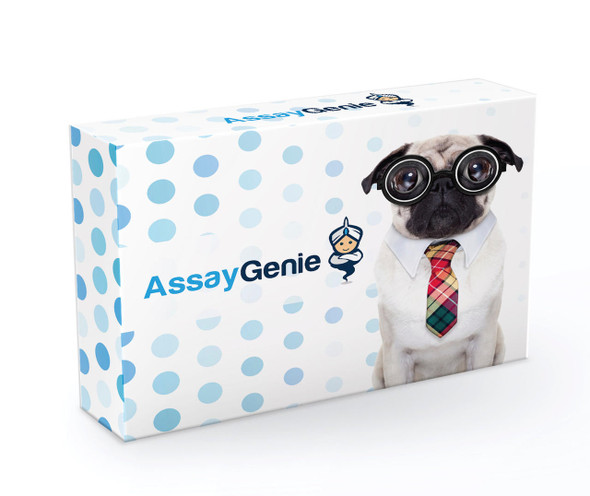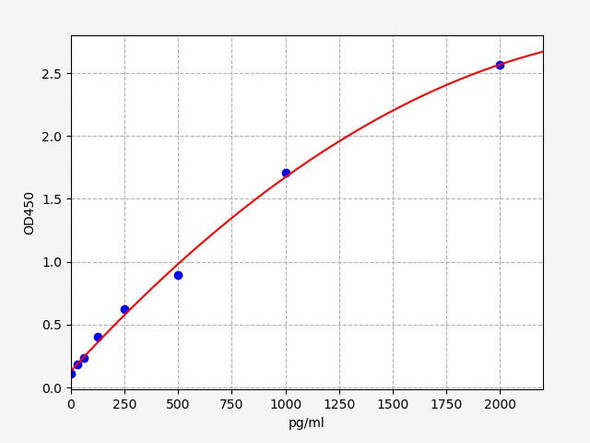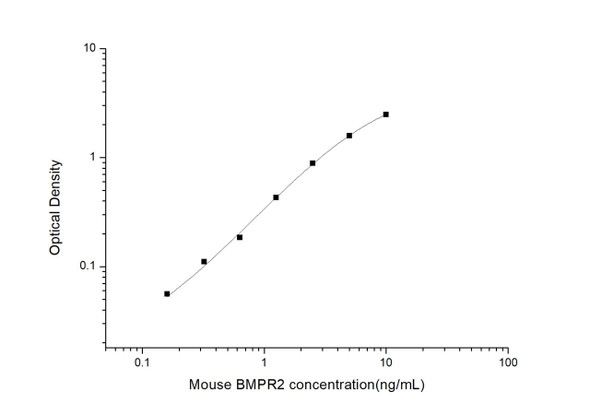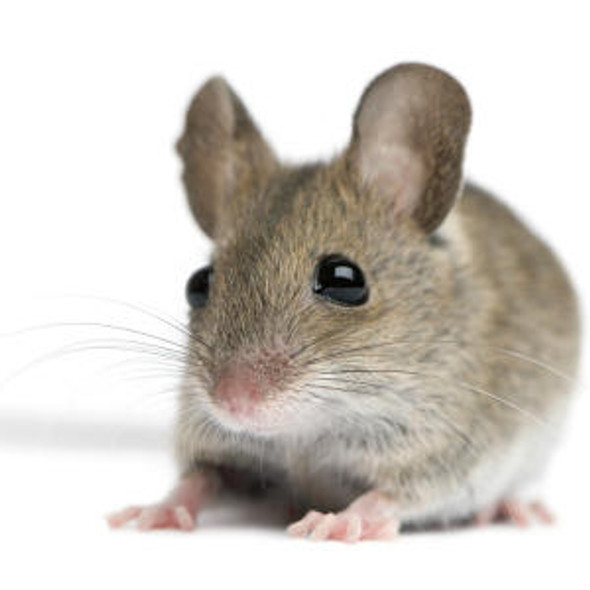Human Cell Biology ELISA Kits 2
Human BMPR2 (Bone Morphogenetic Protein Receptor II) ELISA Kit (HUES01763)
- SKU:
- HUES01763
- Product Type:
- ELISA Kit
- Size:
- 96 Assays
- Uniprot:
- Q13873
- Sensitivity:
- 0.09ng/mL
- Range:
- 0.16-10ng/mL
- ELISA Type:
- Sandwich
- Synonyms:
- BMPR-II, BMPR3, BMR2, BRK-3, PPH1, T-ALK
- Reactivity:
- Human
- Sample Type:
- Serum, plasma and other biological fluids
- Research Area:
- Cell Biology
Description
| Assay type: | Sandwich |
| Format: | 96T |
| Assay time: | 4.5h |
| Reactivity: | Human |
| Detection Method: | Colormetric |
| Detection Range: | 0.16-10 ng/mL |
| Sensitivity: | 0.10 ng/mL |
| Sample Volume Required Per Well: | 100µL |
| Sample Type: | Serum, plasma and other biological fluids |
| Specificity: | This kit recognizes Human BMPR2 in samples. No significant cross-reactivity or interference between Human BMPR2 and analogues was observed. |
This ELISA kit uses Sandwich-ELISA as the method. The micro ELISA plate provided in this kit has been pre-coated with an antibody specific to Human BMPR2. Standards or samples are added to the appropriate micro ELISA plate wells and combined with the specific antibody. Then a biotinylated detection antibody specific for Human BMPR2 and Avidin-Horseradish Peroxidase (HRP) conjugate are added to each micro plate well successively and incubated. Free components are washed away. The substrate solution is added to each well. Only those wells that contain Human BMPR2, biotinylated detection antibody and Avidin-HRP conjugate will appear blue in color. The enzyme-substrate reaction is terminated by adding Stop Solution and the color turns yellow. The optical density (OD) is measured spectrophotometrically at a wavelength of 450 nm ± 2 nm. The OD value is proportional to the concentration of Human BMPR2. The concentration of Human BMPR2 in samples can be calculated by comparing the OD of the samples to the standard curve.
| UniProt Protein Function: | BMPR2: a serine/threonine-protein kinase receptor for bone morphogenetic protein (BMP). Binds to BMP-7, BMP-2 and, less efficiently, BMP-4. Binding is weak but enhanced by the presence of type I receptors for BMPs. On ligand binding, forms a receptor complex consisting of two type II and two type I transmembrane serine/threonine kinases. Type II receptors phosphorylate and activate type I receptors which autophosphorylate, then bind and activate SMAD transcriptional regulators. Defects in BMPR2 are the cause of primary pulmonary hypertension (PPH1), a weakly penetrant dominant disorder, associated with lesions in pulmonary arterioles, elevated pulmonary arterial pressure, and right ventricular failure. |
| UniProt Protein Details: | Protein type:EC 2. 7. 11. 30; Kinase, protein; Cell cycle regulation; Protein kinase, TKL; Membrane protein, integral; Protein kinase, Ser/Thr (receptor); TKL group; STKR family; Type2 subfamily Chromosomal Location of Human Ortholog: 2q33-q34 Cellular Component: extracellular space; cell surface; cell soma; integral to plasma membrane; apical plasma membrane; dendrite; cytoplasm; plasma membrane; basal plasma membrane; caveola Molecular Function:transforming growth factor beta receptor activity; protein binding; growth factor binding; metal ion binding; activin receptor activity, type II; ATP binding; receptor signaling protein serine/threonine kinase activity Biological Process: limb development; transcription from RNA polymerase II promoter; regulation of lung blood pressure; activin receptor signaling pathway; protein amino acid phosphorylation; anterior/posterior pattern formation; BMP signaling pathway; proteoglycan biosynthetic process; lymphangiogenesis; transmembrane receptor protein serine/threonine kinase signaling pathway; positive regulation of BMP signaling pathway; negative regulation of systemic arterial blood pressure; chondrocyte development; positive regulation of bone mineralization; cellular response to starvation; negative regulation of vasoconstriction; regulation of cell proliferation; positive regulation of osteoblast differentiation; mesoderm formation; positive regulation of axon extension involved in axon guidance; positive regulation of endothelial cell proliferation; blood vessel remodeling; brain development; negative regulation of cell growth; vascular endothelial growth factor receptor signaling pathway; alveolus development Disease: Pulmonary Venoocclusive Disease 1, Autosomal Dominant; Pulmonary Hypertension, Primary, 1 |
| NCBI Summary: | This gene encodes a member of the bone morphogenetic protein (BMP) receptor family of transmembrane serine/threonine kinases. The ligands of this receptor are BMPs, which are members of the TGF-beta superfamily. BMPs are involved in endochondral bone formation and embryogenesis. These proteins transduce their signals through the formation of heteromeric complexes of two different types of serine (threonine) kinase receptors: type I receptors of about 50-55 kD and type II receptors of about 70-80 kD. Type II receptors bind ligands in the absence of type I receptors, but they require their respective type I receptors for signaling, whereas type I receptors require their respective type II receptors for ligand binding. Mutations in this gene have been associated with primary pulmonary hypertension, both familial and fenfluramine-associated, and with pulmonary venoocclusive disease. [provided by RefSeq, Jul 2008] |
| UniProt Code: | Q13873 |
| NCBI GenInfo Identifier: | 15451916 |
| NCBI Gene ID: | 659 |
| NCBI Accession: | NP_001195. 2 |
| UniProt Secondary Accession: | Q13873,Q16569, Q4ZG08, Q53SA5, Q585T8, |
| UniProt Related Accession: | Q13873 |
| Molecular Weight: | 115,201 Da |
| NCBI Full Name: | bone morphogenetic protein receptor type-2 |
| NCBI Synonym Full Names: | bone morphogenetic protein receptor, type II (serine/threonine kinase) |
| NCBI Official Symbol: | BMPR2 |
| NCBI Official Synonym Symbols: | BMR2; PPH1; BMPR3; BRK-3; T-ALK; BMPR-II |
| NCBI Protein Information: | bone morphogenetic protein receptor type-2; BMPR-2; BMP type-2 receptor; BMP type II receptor; type II activin receptor-like kinase; bone morphogenetic protein receptor type II; type II receptor for bone morphogenetic protein-4 |
| UniProt Protein Name: | Bone morphogenetic protein receptor type-2 |
| UniProt Synonym Protein Names: | Bone morphogenetic protein receptor type II |
| Protein Family: | Bone morphogenetic protein receptor |
| UniProt Gene Name: | BMPR2 |
| UniProt Entry Name: | BMPR2_HUMAN |
As the OD values of the standard curve may vary according to the conditions of the actual assay performance (e. g. operator, pipetting technique, washing technique or temperature effects), the operator should establish a standard curve for each test. Typical standard curve and data is provided below for reference only.
| Concentration (ng/mL) | O.D | Average | Corrected |
| 10 | 2.421 2.473 | 2.447 | 2.358 |
| 5 | 1.639 1.647 | 1.643 | 1.554 |
| 2.5 | 0.973 0.961 | 0.967 | 0.878 |
| 1.25 | 0.498 0.534 | 0.516 | 0.427 |
| 0.63 | 0.282 0.26 | 0.271 | 0.182 |
| 0.32 | 0.198 0.182 | 0.19 | 0.101 |
| 0.16 | 0.139 0.143 | 0.141 | 0.052 |
| 0 | 0.085 0.093 | 0.089 | -- |
Precision
Intra-assay Precision (Precision within an assay): 3 samples with low, mid range and high level Human BMPR2 were tested 20 times on one plate, respectively.
Inter-assay Precision (Precision between assays): 3 samples with low, mid range and high level Human BMPR2 were tested on 3 different plates, 20 replicates in each plate.
| Intra-assay Precision | Inter-assay Precision | |||||
| Sample | 1 | 2 | 3 | 1 | 2 | 3 |
| n | 20 | 20 | 20 | 20 | 20 | 20 |
| Mean (ng/mL) | 0.53 | 1.10 | 3.37 | 0.56 | 1.11 | 3.14 |
| Standard deviation | 0.04 | 0.05 | 0.12 | 0.03 | 0.05 | 0.14 |
| C V (%) | 7.55 | 4.55 | 3.56 | 5.36 | 4.50 | 4.46 |
Recovery
The recovery of Human BMPR2 spiked at three different levels in samples throughout the range of the assay was evaluated in various matrices.
| Sample Type | Range (%) | Average Recovery (%) |
| Serum (n=5) | 85-96 | 90 |
| EDTA plasma (n=5) | 88-103 | 95 |
| Cell culture media (n=5) | 87-101 | 92 |
Linearity
Samples were spiked with high concentrations of Human BMPR2 and diluted with Reference Standard & Sample Diluent to produce samples with values within the range of the assay.
| Serum (n=5) | EDTA plasma (n=5) | Cell culture media (n=5) | ||
| 1:2 | Range (%) | 97-109 | 97-108 | 87-101 |
| Average (%) | 103 | 103 | 94 | |
| 1:4 | Range (%) | 92-105 | 81-96 | 86-99 |
| Average (%) | 99 | 87 | 91 | |
| 1:8 | Range (%) | 87-100 | 83-98 | 89-101 |
| Average (%) | 93 | 89 | 94 | |
| 1:16 | Range (%) | 89-103 | 80-90 | 87-101 |
| Average (%) | 95 | 85 | 93 |
An unopened kit can be stored at 4°C for 1 month. If the kit is not used within 1 month, store the items separately according to the following conditions once the kit is received.
| Item | Specifications | Storage |
| Micro ELISA Plate(Dismountable) | 8 wells ×12 strips | -20°C, 6 months |
| Reference Standard | 2 vials | |
| Concentrated Biotinylated Detection Ab (100×) | 1 vial, 120 µL | |
| Concentrated HRP Conjugate (100×) | 1 vial, 120 µL | -20°C(shading light), 6 months |
| Reference Standard & Sample Diluent | 1 vial, 20 mL | 4°C, 6 months |
| Biotinylated Detection Ab Diluent | 1 vial, 14 mL | |
| HRP Conjugate Diluent | 1 vial, 14 mL | |
| Concentrated Wash Buffer (25×) | 1 vial, 30 mL | |
| Substrate Reagent | 1 vial, 10 mL | 4°C(shading light) |
| Stop Solution | 1 vial, 10 mL | 4°C |
| Plate Sealer | 5 pieces | |
| Product Description | 1 copy | |
| Certificate of Analysis | 1 copy |
- Set standard, test sample and control (zero) wells on the pre-coated plate and record theirpositions. It is recommended to measure each standard and sample in duplicate. Note: addall solutions to the bottom of the plate wells while avoiding contact with the well walls. Ensuresolutions do not foam when adding to the wells.
- Aliquot 100 µL of standard solutions into the standard wells.
- Add 100 µL of Sample / Standard dilution buffer into the control (zero) well.
- Add 100 µL of properly diluted sample (serum, plasma, tissue homogenates and otherbiological fluids) into test sample wells.
- Cover the plate with the sealer provided in the kit and incubate for 90 min at 37 °C.
- Aspirate the liquid from each well, do not wash. Immediately add 100 µL of BiotinylatedDetection Ab working solution to each well. Cover the plate with a plate seal and gently mix. Incubate for 1 hour at 37 °C.
- Aspirate or decant the solution from the plate and add 350 µL of wash buffer to each welland incubate for 1-2 minutes at room temperature. Aspirate the solution from each well andclap the plate on absorbent filter paper to dry. Repeat this process 3 times. Note: a microplatewasher can be used in this step and other wash steps.
- Add 100 µL of HRP Conjugate working solution to each well. Cover with a plate seal andincubate for 30 min at 37 °C.
- Aspirate or decant the solution from each well. Repeat the wash process for five times asconducted in step 7.
- Add 90 µL of Substrate Reagent to each well. Cover with a new plate seal and incubate forapproximately 15 min at 37 °C. Protect the plate from light. Note: the reaction time can beshortened or extended according to the actual color change, but not by more than 30min.
- Add 50 µL of Stop Solution to each well. Note: Adding the stop solution should be done inthe same order as the substrate solution.
- Determine the optical density (OD value) of each well immediately with a microplate readerset at 450 nm.






